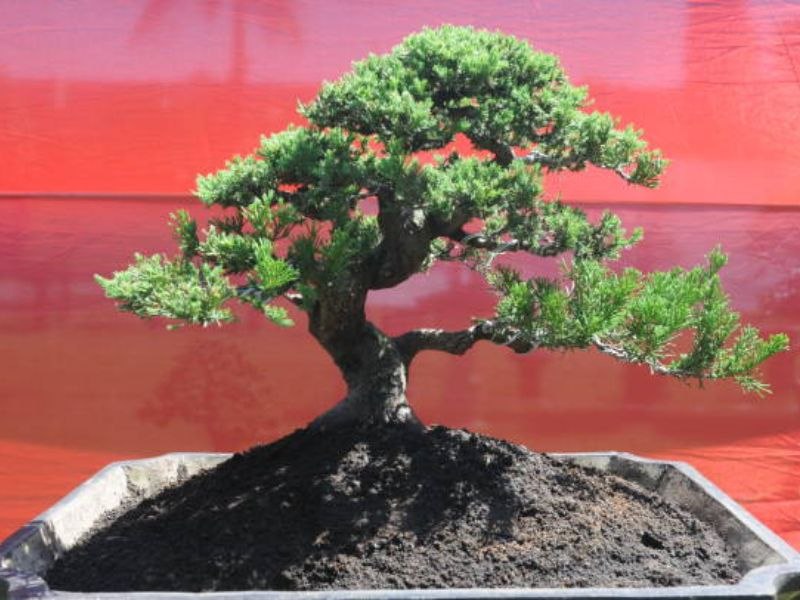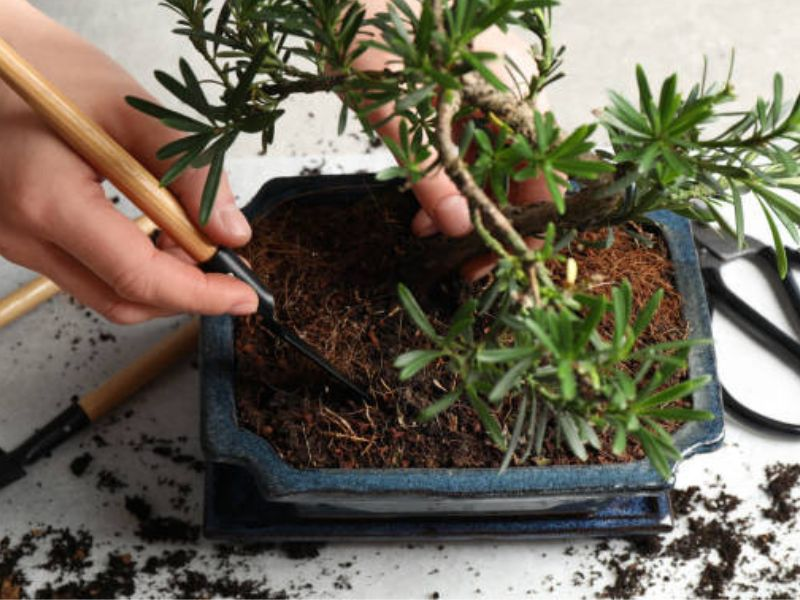The right juniper bonsai soil is not just about planting; it’s a critical choice that affects the vitality and growth of your bonsai. In the intricate world of bonsai cultivation, understanding the specific needs of your juniper is key. This guide aims to demystify the process, ensuring you provide the best ground for your tree to thrive.
Navigating through the various soil options can be daunting for those new to caring for a juniper bonsai tree, often recommended as a beginner tree due to its resilience. But with the right knowledge, it becomes an artful expression of care. We’ll take you through the essential considerations, from soil composition to nutrient balance, to help your juniper bonsai flourish.
Let’s lay the groundwork for a thriving bonsai together.
The Essential Soil Properties For Juniper Bonsai
The health of a juniper bonsai hinges on three essential soil properties:
- Drainage
- Water retention
- Aeration
Each plays a pivotal role in the wellbeing of these miniature trees.
Drainage is crucial; without it, water can accumulate at the roots of juniper trees, leading to detrimental conditions such as root rot. Yet, the soil must also retain enough moisture between watering to keep the bonsai hydrated, striking a delicate balance that nurtures the tree without overwhelming it.

Equally important is aeration. The roots of a juniper bonsai need oxygen to function and grow; compact soil can suffocate them, stunting growth and vitality. A well-aerated soil allows roots to breathe and encourages the beneficial microbial activity that contributes to the overall health of the bonsai.
Understanding these soil properties is the first step towards creating an environment where your juniper bonsai can prosper.
Decoding Soil Mix Components
A well-composed bonsai soil mix is a tapestry of various elements, each contributing unique benefits to the cultivation of a juniper bonsai.
Organic potting compost offers a wealth of nutrients, acting as a slow-releasing food source for the bonsai’s roots. This component decomposes gradually, ensuring a steady supply of organic matter that supports root growth and health.
Peat moss, a staple in potting soil and other organic elements, plays a significant role in water retention for bonsai mixes. It helps the soil maintain moisture without becoming waterlogged, providing the roots of a bonsai with a humid environment that’s conducive to growth. However, balance is key, as too much peat can lead to overly acidic conditions.
Fine gravel or similar inorganic components like volcanic rock or fired clay ensure the soil remains loose and friable, promoting excellent drainage and aeration. They create tiny pockets within the soil structure, allowing water to flow freely and roots to access the air they require. The inclusion of such materials is essential to prevent soil compaction, which can be detrimental to juniper bonsai health.
The Science Of Soil: pH And Nutrient Balance
The pH level of the soil determines how well your bonsai can absorb nutrients. Junipers prefer slightly acidic to neutral soil, usually between 5.5 and 7.0 on the pH scale. If the soil is too acidic or too alkaline, the tree may struggle to take up essential nutrients, leading to poor growth and a lack of vigor.
Nutrient balance is equally crucial. Juniper bonsai trees require a mix of macro and micronutrients, including nitrogen, phosphorus, potassium, and various trace elements, to maintain their miniature stature and lush foliage. Over-fertilization can cause as much harm as nutrient deficiencies, leading to burn roots or excessive growth that detracts from the bonsai’s aesthetic.
To maintain this balance, regular testing and adjustments are necessary. Soil pH can be modified using sulfur to increase acidity or lime to reduce it. Fertilizers should be applied judiciously, preferably during the growing season, and in line with the specific needs of the plant, which can vary throughout the year.
Commercial Mixes vs. Tailor-Made Mixes
When it comes to juniper bonsai soil, enthusiasts face a choice between commercial mixes and creating a custom blend. Commercial bonsai soils are convenient, often scientifically formulated with a balance of components designed to suit a wide range of bonsai trees, including junipers.
They offer a quick and easy solution for those new to bonsai cultivation, ensuring that the essential needs of drainage, aeration, and nutrient retention are broadly met.
However, the one-size-fits-all nature of commercial mixes may not always cater to the specific needs of a juniper bonsai, which can vary based on the local climate, the specific species of juniper, and individual care routines. Tailor-made mixes, on the other hand, allow for complete control over the soil composition.
By customizing the mix, you can adjust factors such as drainage and water retention to match the precise requirements of your tree.
Creating a custom soil mix can be more time-consuming and requires a deeper understanding of soil science and juniper needs. It can also be more cost-effective in the long run and allows for adjustments as the tree grows and its needs change. While commercial mixes are about convenience, custom mixes are about precision.
Both have their place in the bonsai world, and the choice often comes down to the preferences and commitment of the bonsai grower.
Crafting The Perfect Juniper Bonsai Soil Mix

Crafting the perfect soil mix for your juniper bonsai, often recommended as one of the beginner trees due to its resilience, is an art that enhances the tree’s beauty and health.
Here’s a step-by-step guide tailored for beginners:
Gather Your Materials
Start by selecting quality ingredients.
You’ll need:
- Akadama, a hard-baked Japanese clay, for water retention and structure.
- Pumice, for aeration and moisture management.
- Lava rock, to ensure proper drainage and add texture.
- Fine pine bark or organic compost, to provide nutrients.
Measure The Components
For juniper bonsai, a general mix ratio is:
- 1 part Akadama
- 1 part Pumice
- 1 part Lava rock
- ½ part Fine pine bark or organic compost
Sifting The Materials
Sift each component to remove dust and very fine particles that can clog the soil. This process helps promote good aeration and drainage.
Mixing
In a large container, combine the components as per the measured ratio to create your soil mixture. Mix thoroughly to ensure an even distribution of materials.
Testing Drainage
Before potting, test the mix’s drainage. Place some soil in a mesh and run water through it. If water flows freely, the mix is well-structured.
Potting Your Bonsai
Gently remove your juniper bonsai from its current pot, brushing away old soil from the roots. Place a layer of the new soil mix at the bottom of the pot, then position your bonsai and add soil around the roots, tapping the pot to settle the mix without air pockets.
Watering After Repotting
Water the bonsai thoroughly after repotting to help the soil settle and eliminate any remaining air gaps.
Creating the perfect soil mix for your juniper bonsai may take a bit of practice, but it is well worth the effort. This tailored environment will support your bonsai’s health, encouraging robust growth and a stunning display.
Soil Pitfalls: What To Avoid
When selecting and mixing soil for juniper bonsai, common pitfalls can hinder the health and growth of your tree. Awareness and careful avoidance of these mistakes are key to nurturing a thriving bonsai.
- Overlooking Drainage: One of the most common mistakes is underestimating the importance of good drainage. Junipers can’t tolerate waterlogged soil; it can lead to root rot, a deadly condition for bonsai trees. Ensure your mix has adequate inorganic components like lava rock to facilitate water flow.
- Ignoring Soil pH: Junipers require a slightly acidic to neutral pH. Ignoring the soil’s pH can lead to nutrient uptake issues. Regularly test the pH and adjust with additives like sulfur or lime to maintain the optimal range.
- Excessive Fertilization: While nutrients are vital, too much fertilizer can burn the delicate roots of a bonsai. Use bonsai-specific fertilizers according to the instructions, and consider the tree’s growth phase before application.
- Neglecting Soil Composition: Using garden soil or an incorrect mix can compact around the roots, suffocating them and preventing proper growth. Always use a well-balanced bonsai soil mix that caters to the specific needs of junipers.
- Using Unscreened Components: Not screening soil components can result in a mix with fine dust that impedes drainage and aeration. Always sift soil components before mixing to remove fine particles.
To avoid these pitfalls, invest in quality soil components, understand the specific needs of your juniper bonsai, and approach soil mixing with precision and care.
Finding The Right Soil For Your Juniper Bonsai
Finding the right soil for your juniper bonsai can be a journey of its own. High-quality soil is paramount, and there are several avenues you can explore to procure it.
- Local Bonsai Nurseries: These specialized nurseries often offer a range of soils tailored for bonsai cultivation, including those perfect for junipers. The advantage of buying here is the staff’s expertise; they can offer valuable advice tailored to your local climate and the specific species of your tree.
- Garden Centers and Home Improvement Stores: While their selections may be broader and less specialized, many garden centers stock juniper bonsai soil or components you can use to mix your own. Staff at these stores can still provide helpful guidance, especially regarding regional soil preferences for juniper bonsai care.
- Online Retailers: A plethora of online stores cater to bonsai enthusiasts, offering ready-made bonsai soils and individual components. Reviews and ratings can guide you to the best products, and detailed product descriptions should help you evaluate the suitability for juniper bonsai.
- Bonsai Forums and Communities: Fellow bonsai growers can be an invaluable resource, often providing insights into the care of specific varieties such as the California juniper. They can share where they get their soil, which may lead you to discover local suppliers or trusted online merchants.
When evaluating options, consider the soil’s drainage capabilities, water retention, and aeration qualities. Ensure that the pH is appropriate for junipers and that the nutrient content matches your tree’s needs. Don’t hesitate to ask suppliers about the origin of their soil and its components, as this can be a good indicator of quality.
Conclusion
Selecting the ideal juniper bonsai soil is vital for the thriving growth of your tree. Keep in mind the balance of drainage, aeration, and moisture your juniper requires. For top-quality gardening needs, visit Leaves and Soul on Amazon, where we offer specially formulated soils and care products.
Share your juniper bonsai experiences with us and check out Leaves and Soul for resources and guidance. Your journey enriches the bonsai community, helping each unique juniper bonsai flourish.





0 Comments